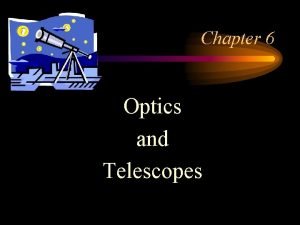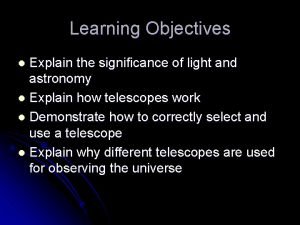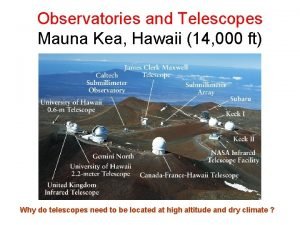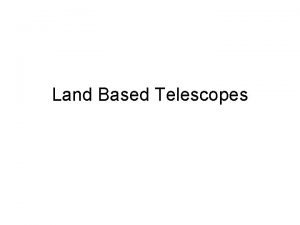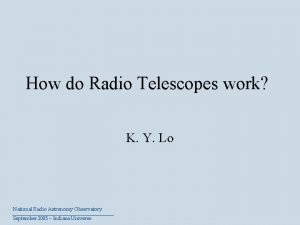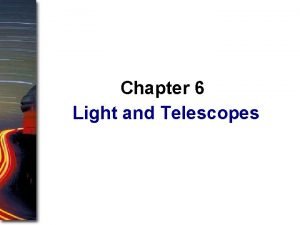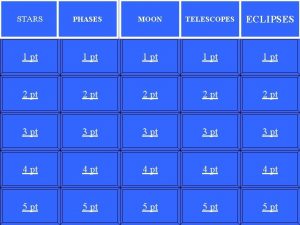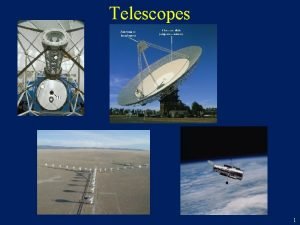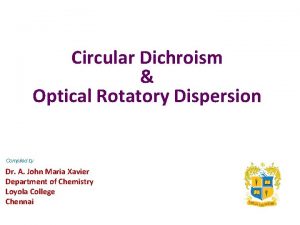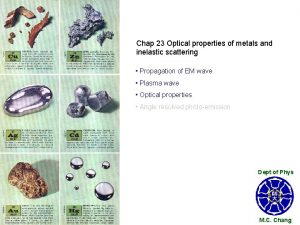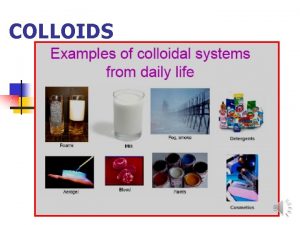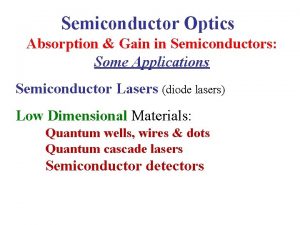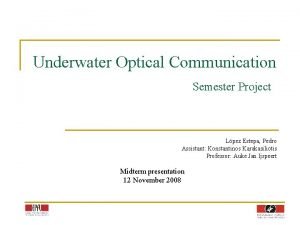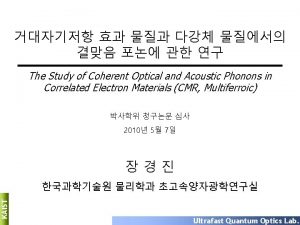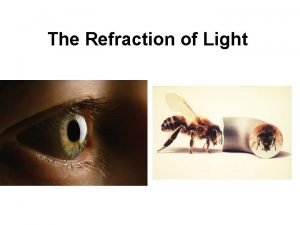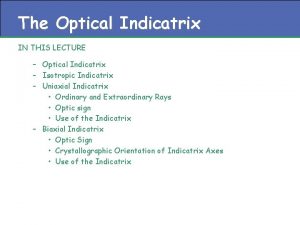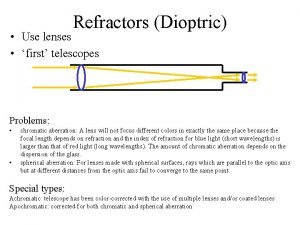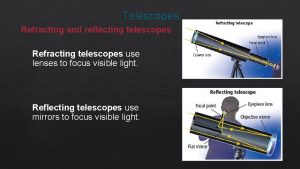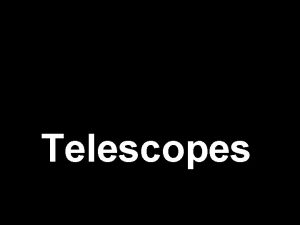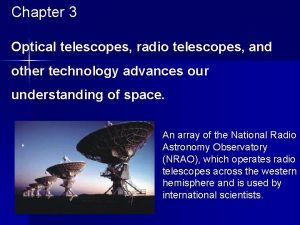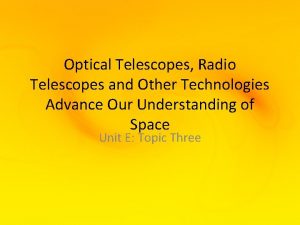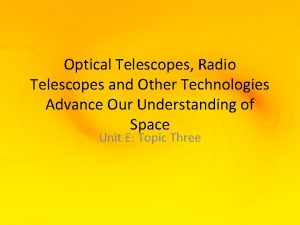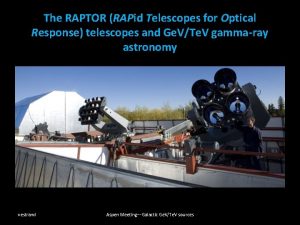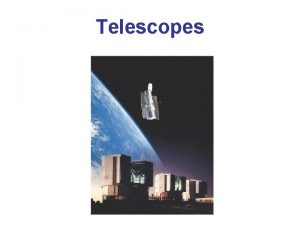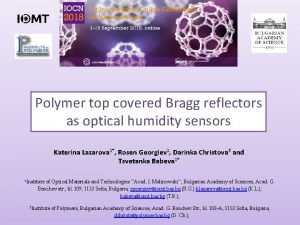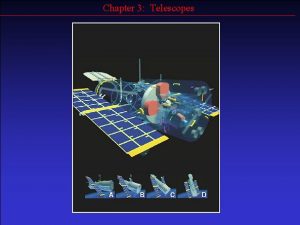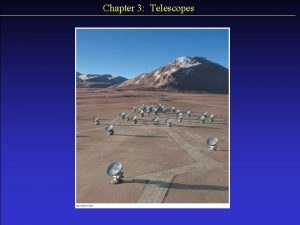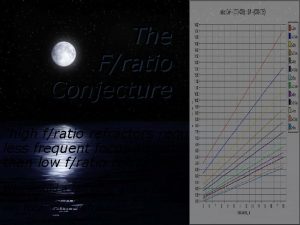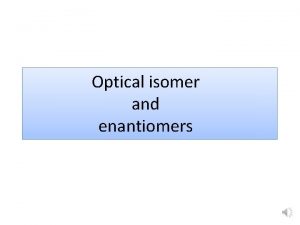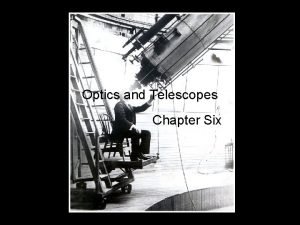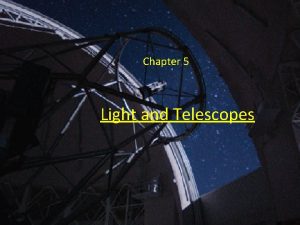Chapter 4 Telescopes Optical telescopes Reflectors and refractors






























- Slides: 30

Chapter 4: Telescopes


Optical telescopes: Reflectors and refractors E O Refractors use lenses E: eyepiece O: objective

Reflectors use mirrors: Newtonian Cassegrain

Objective (O) = Main light-gathering surface (lens or mirror) Aperture = a = Diameter of objective ("size" of telescope) Focal length = f = Distance from objective to image ("length" of telescope) Eyepiece (E) = Lens used to inspect image from objective

1) LIGHT GATHERING POWER (how faint you can see) LGP ~ a 2 (Bigger = better) 2) MAGNIFYING POWER (how large image is) MP = f(O) / f(E) (Bigger = better) So can change this with eyepice choice, not a fundamental property of telescope Practical limit 50 x O (in inches) 3) RESOLVING POWER (size of detail, sharpness of focus) Size of detail ~ 1/a (Smaller = better) i. e. , larger ‘a’ allows smaller details to be seen


Resolution vs. magnification


Airy disk. Light coming through a circular aperture



Resolution vs. magnification

Atmospheric seeing


The planet Uranus imaged in the infrared

Spitzer Space Telescope An infrared telescope in orbit around the Sun!


43 m diameter



How to improve resolution? Radio interferometry The Very Large Array, Socorro, New Mexico

VLBI

Chandra Xray observatory

X-ray telescope design (Chandra X-ray Observatory) It is very difficult to focus (redirect) high energy photons, because they are so readily absorbed by matter. Thus it is difficult to tell where they came from, and to reconstruct the image.

Chandra image of X-rays emitted from hot gas surrounding galaxy Cygnus-A

An Xray image of a black hole, by Chandra.

X-ray image Visible (optical) Hot stars give off a lot more Xrays than cooler stars do.

Observing gamma rays Space-based telescopes (Compton Gamma ray Observatory

 All modern large optical telescopes are refractors.
All modern large optical telescopes are refractors. Famous manifestors human design
Famous manifestors human design Significance of light
Significance of light A building that contains one or more telescopes
A building that contains one or more telescopes Chromatic aberration affects reflector telescopes
Chromatic aberration affects reflector telescopes Land based telescopes
Land based telescopes Computer controlled telescopes
Computer controlled telescopes How do radio telescopes work
How do radio telescopes work Modern telescopes make it possible for astronomers
Modern telescopes make it possible for astronomers Guidepost of light
Guidepost of light New moon telescopes
New moon telescopes Star testing telescopes
Star testing telescopes History of telescopes timeline
History of telescopes timeline How do telescopes work
How do telescopes work Introduction to ocr
Introduction to ocr Advantage and disadvantage of fibre optic cable
Advantage and disadvantage of fibre optic cable Circular dichroism and optical rotatory dispersion
Circular dichroism and optical rotatory dispersion Optical properties of metals and nonmetals
Optical properties of metals and nonmetals Tyndall effect is an optical property
Tyndall effect is an optical property Semiconductor
Semiconductor By communicating the outside world
By communicating the outside world Optical switching and networking
Optical switching and networking Optical illusions science fair projects
Optical illusions science fair projects A ray of light travels from an optical denser
A ray of light travels from an optical denser Numerical aperture optical fiber
Numerical aperture optical fiber Underwater optical control
Underwater optical control Optical vs acoustic phonons
Optical vs acoustic phonons Polarization of light
Polarization of light Isotropic indicatrix
Isotropic indicatrix Material dispersion
Material dispersion Amino acid optical isomers
Amino acid optical isomers
